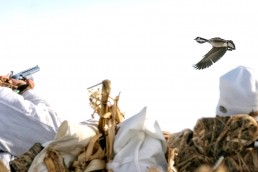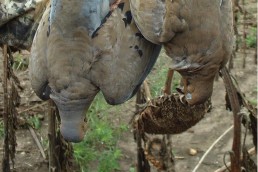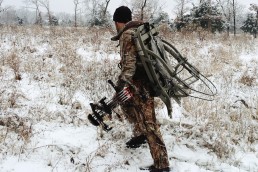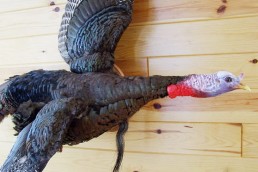Have We Reached the Zenith of Shotshell Development? Part two
SHARE THIS POST
Early steel loads went through some troubling times, but today we have a complete success story to tell. If you hear anyone claiming that steel loads are junk and saying they wouldn’t shoot them “under any circumstances,” you can kindly point them to retailers that sell the latest version
Speed triumphs
The key to these state-of-the-art loads: velocity, and lots of it. Speeds started inching up about a decade ago, and have now reached the point of exceeding any level of pellet speed ever considered for target or game loads.
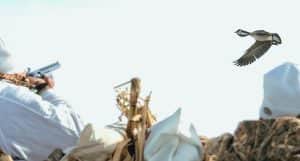
In clay shooting, the Double A 1450 fps cuts up targets and turns them into vapor over the barrel of a trap or skeet gun. In game loads (even some heavy payloads), 1450 to 1500 fps is a running average, and loads like Hypersonic by Remington press the speed limit to 1700 fps. And in some cases based on my chronograph recordings, even faster.
We have indeed hit the wall in terms of what powders, bore steel and related shotshell components can take on. Today, we have three classes of factory lead-alternative shotshells for field use.
First, there are low-tech flake loads for dove hunting, general purpose and other small birds. Second, there are mid-range heavy hitters, as in standard game loads. Third, the upper crust in performance, are Winchester “Black Bullets,” a term I like to use. Federal advance sabot load designs, Kent Fast Steel and the previously mentioned Hypersonic speedsters by Remington, finish out the primary list of options.
Due in part to the fact that a shotgun’s chamber pressure can’t withstand any more push on the action’s breech, the race for speed and energy against the chamber walls has reached its maximum level of performance.
Heavy Shot, in the “designer load” department, holds the reins in terms of high-performance tungsten loads that are fast, but due to pellet mass, don’t require the kind of super velocity found in iron shot ammunition.
So what’s next?
About all that remains are computer-programmed ammo, as is in the military’s timed-distance rounds. And with all the sitting in the tactical department, that is not where this overview is leading at all. Because shotshells retain a good deal of extra space, there are things that can be done to a payload so as to allow it to react at very specific ranges against soft or hard targets. I would guess that in that area there will be some additional development for some time to come.
Are you enjoying this post?
You can be among the first to get the latest info on where to go, what to use and how to use it!
In terms of the big three and several others close behind them, all current loads are state-of-the-art—period. In other words, it is all good ammo in smooth bore guns, but some brands tend to favor one direction in development over another, making for a unique set of options in shotshell ammunition.
The good news is that all of it, regardless of brand, does the job downrange, and from what I can tell, all are solid products in terms of materials and quality control.
Specializing seems to be key
Practical field application is always the supreme test. We have seen the whole nine yards, in terms of advanced load development around shotshells. Two seasons ago, a large group of writers, while shooting the new Blind Side Winchester loads at R&R Hunting South Dakota, managed to drop more than 150 pheasants without using up all the ammo brought to the hunt. The longest ranged kill with #2 pellets was 70 yards, stone dead. Not the silver bullet-deal with a single pellet in the head, but a spray of body penetration pellets that took the big rooster out. While this was a good example of maximum, effective harvesting power, rest assured there were many outstanding solid 50- to 60-yard kills by blockers over corn.
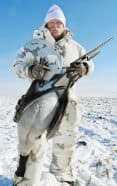
Remington Hypersonic ultra-fast movers were pressed to hundreds of Canada geese in Canada, and large Maxima Canadas along the Missouri River in eastern South Dakota. From in-your-face decoy gunning to extended range fringe bird shooting, I would bet that the Remington ultra-fast loads would stay with even the best lead shot goose loads back in the day. If not, they would push them aside due to the outstanding patterning abilities of true round steel shot. (Black Cloud, by Federal, was hard-nose tested against both waterfowl and pheasants during two full seasons by myself before ever uttering or writing a single word). When taken afield after general testing, all these specialized steel shot loads discussed above were often selected over lead shot loads sitting side by side in the staging area at the ranch where most of my field research takes place. At one point, we had an actual shoot-out with a crew of hunters from Minnesota that was packing 3-inch lead shot, 1 7/8-ounce loads against wild Dakota ringed-necks. We shot Remington Hypersonic that day in #4 steel, and three of us outgunned the Gopher-state crew of five hunters by three birds to one.
At this point, we have something called “advanced selected specialization” when it comes to shotshells. There is a load being sold for every purpose that you can come up with: clay target, general purpose, advanced coyote/varmint, hogs/bore, waterfowl, big game and more.
Much of this shotgun ammo is currently offered packed with lead-alternative pellets for use in special areas, or over water. It is likely we will see additional products in the future as well. After all, regulations banning the use of lead shot are becoming more common across the landscape.
L.P. Brezny has worked in research and development across the shooting industry for 37 years. He has developed and marketed systems for 12 gauges, designed ammunition for Winchester and Federal Cartridge, designed separator quiet slugs, shotshells and one-choke do-it-all systems. Brezny was the first ballistics writer to measure shotgun pellets in flight to ranges as great as 100 yards. He has published three books on shooting (Gun Digest Books), and is completing a fourth on long-range rifle applications. He has published hundreds of articles on sending rounds downrange.
MWO
SHARE THIS POST
Did you enjoy this post?
You can be among the first to get the latest info on where to go, what to use and how to use it!
L.P. Brezny
Writing on outdoor subjects for over 40 years, L.P. Brezny has written four books on shotgun and rifle (ballistics and performance). He’s an expert at smoothbore, and high-power, ultra-long-range shooting. He’s a specialist, producing reviews covering general products used in the outdoors industry.
